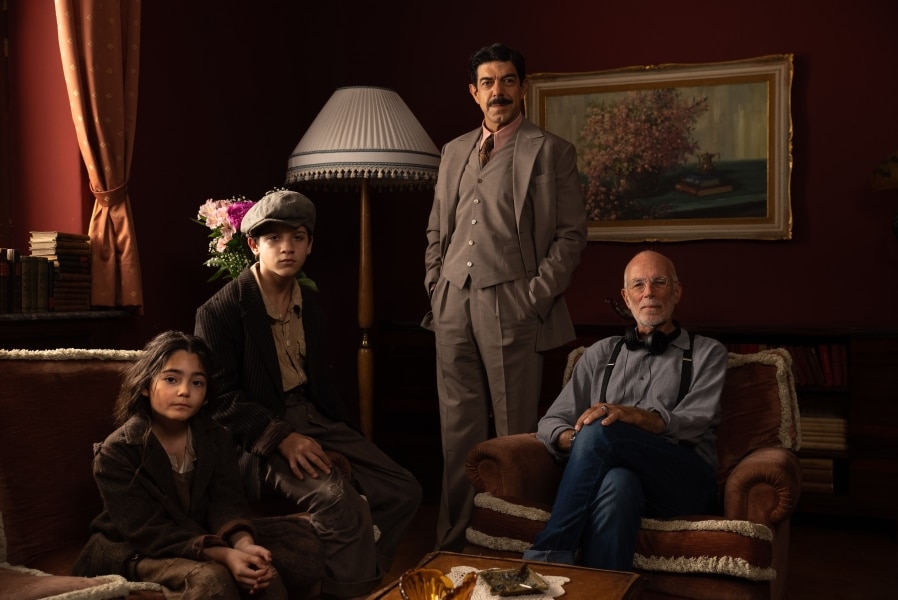It comes out in Italian theaters today (Nov. 21) but does not yet have a U.S. release, although Naples – New York, the latest film by Oscar-winning director Gabriele Salvatores will undoubtedly arrive in American theaters soon. At least because of the theme it deals with, namely Italian immigration to America in the postwar period.
Based on a screenplay written by Federico Fellini with Tullio Pinelli and found among the screenwriter’s papers, it is a kind of fable for adults that tells the story of two children in the immediate postwar period, and begins amid the rubble of a Naples bent by misery.
Carmine and Celestina, two scugnizzelli left without a family, aged 12 and 9 respectively, contrive to survive as best they can, helping each other. Until one night, almost unintentionally, they end up embarked as stowaways on a steamer bound for New York, where Celestina’s sister, who had emigrated months earlier, lives. United with the many Italian emigrants seeking their fortune, they disembark in an unfamiliar metropolis, which, after numerous vicissitudes, they will learn to call home.
The two outstanding little actors, with whom you will fall in love at first sight, are Antonio Guerra and Dea Lanzaro; in the cast alongside them are Pierfrancesco Favino, Anna Ammirati, Omar Benson Miller, Anna Lucia Pierro, Tomas Arana and Antonio Catania.
Salvatores, why did you decide to tell a story like this?
“I had come into possession of this manuscript by Fellini and Pinelli, a ‘screenplay treatment’ of about 80 pages about which practically nothing was known, and it already seemed like a wonderful thing. When I later read it, the wonder became desire and creative drive. The story is beautiful, the themes of travel, elsewhere and solidarity I have often dealt with in my films, and working with children has always given me joy. Children do not “act,” they really live what they are doing in a very serious “game.” It is no accident that in English ‘to act’ is ‘to play,’ the same verb used for ‘to play.'”
The topic of emigration is still very relevant today.
“Absolutely. And in fact I was faced with an adventurous, funny and moving story about how we used to be the “migrants,” the “foreigners,” the “different ones.” Today we are living in a historical moment full of distrust and hatred, and I felt like making a film about solidarity. Because if we look closely at those who are different from us, if we get to know them, then we can also love them. This film wants to offer a little break to the nastiness that rages in the world, and I hope it makes us think that all in all we can also be better than we are.”
Can you tell us how you arrived at the script?
“Through an incredible journey. There is a book coming out these days in Italy published by Marsilio and titled precisely Naples-New York, in which the editor himself, Augusto Sainati, a university professor and film critic, tells us about it. He told me about it personally. In short: Sainati was a friend of Pinelli’s and one afternoon, when the screenwriter was already quite old, he had gone to visit him. On leaving, Pinelli asked him a kindness: I have a trunk full of paperwork, please take it away and burn it. Sainati gets curious: what kind of paperwork? He says: mah, stuff written with Fellini. So Sainati answers him: all right, I’ll take it away, but before I burn it I’ll read it. So the manuscript of Naples – NewYork ended up together with another one, which, however, was quite complicated and less interesting, in the study of Carlo Patrizi, the historical lawyer of Cinecittà. And eventually it was proposed to me.”
How did you respond?
“Initially I was very afraid of it. Then I found out that there was a lot about me and that maybe I could use it.”
What did the original manuscript look like?
“The story was written in the late 1940s, before Fellini fine-tuned the personal poetics that made him world famous. The story is organized in the traditional way, in the classic three acts, and although we can speak of magic realism, the story does not contain the surreal and dreamlike elements that characterized the Maestro’s later production. It belongs to a moment of transition in our cinema, from neo-realism to Italian-style comedy and the first attempts at a more “fantastic” cinema. Fellini, by the way, had collaborated on the screenplay for Paisà, Roberto Rossellini’s ’46 film, which he himself mentions in the subject. Napoli – New York is inspired by a true story told like a fable, written with great skill in keeping the viewer’s attention with continuous twists and turns. A “classic” film we could say, but with a very modern soul. After all, Fellini said that reality is often disappointing.”
And how did you work on the adaptation?
“The treatment was very detailed, with precise situations and dialogue, and from this point of view I kept as faithful as possible to the original. The court proceedings involving Celestina’s sister are largely inspired by the real thing, because the first woman sentenced to death in the United States was indeed an Italian I tried to tighten the narrative even more and to “modernize” some situations that seemed to me to be too tied to a sensibility and narrative tone that are now obsolete. America and Americans, for example, are sometimes still seen as shrouded in a somewhat too “benevolent” aura, that of a place where dreams come true. However, I did not have to intervene much, because the two authors’ outlook is very current and sometimes even harsh.”
What has changed instead?
The ending, which in my opinion was not well closed, but maybe that was because the subject had been somewhat abandoned. And then the part that takes place in New York, because Fellini himself writes: Naples we know how to tell, but in America we have never been there and so we imagined it a little. It was this statement of his, in fact, that gave me the directive key to the film. After all, the America that I have always loved for its cinema, music and literature today is no longer that. And at the time Fellini was writing there was perhaps too much faith in the ability of the American people to understand the difficulties of others.”
The article Naples-New York is released in Italy: interview with Gabriele Salvatores comes from IlNewyorkese.

